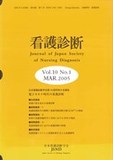Japanese
English
- 有料閲覧
- Abstract 文献概要
- 参考文献 Reference
学生は実習で,長期入院を余儀なくされる血液疾患をもつ対象者の健康問題を明らかにするために,ロイ適応看護モデルを活用した.対象者5名の示す反応から“役割間葛藤”と診断し,介入した成果から,診断に至る「手がかり」の成果を明らかにした.研究方法は,学生が得た情報と情報の解釈から導き出された“役割間葛藤”の診断の手がかりを見いだすために,実習記録と学生の反応から,また介入時に同行して対象者の示す反応から分析した.その結果,学生は適応モデルの役割機能様式を活用して,情報の選択的注意と言語的手がかりを得て,アセスメントを行った.これによって入院による道具的行動の限界に対して表出的行動に関する介入を行い,その成果がみられた.健康障害をもって入院生活を余儀なくされたとき,看護診断の一連の過程で対象者の感情状態や自己知覚と,置かれている状況との相互作用において,対象者自らが対処行動を見いだし,“役割間葛藤”に対処したことは,学生の診断のための手がかりが有効であることが示唆された.
Students used, in their practical training, the Roy Adaptation Model to clarify nursing diagnoses of subjects with blood disease who have to be hospitalized for a long time. Based on the responses shown by the five subjects,“Interrole Conflict”was diagnosed, and the result of the cues to reach the diagnosis was clarified based on the result of intervention. As a result, students conducted assessment by obtaining selective attention and linguistic cues, using the role function mode of the adaptation model. Through this, expressive behavior was intervened with, as instrumental behavior through hospitalization was limited, and its achievement was noted. When hospitalization was necessary due to health problems, the subjects themselves discovered coping behavior in interaction with their own emotional state, self-perception, and the situation, in the series of processes of nursing diagnosis; and coped with interrole conflict, which indicated effectiveness of the students' cues for diagnosis.
Copyright © 2005, Japan Society of Nursing Diagnosis. All rights reserved.


